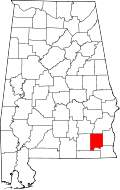Fort Rucker
| Fort Rucker | |
|---|---|
| Fort Rucker, Alabama | |
 | |
 Fort Rucker | |
| Coordinates | 31°20′12″N 85°42′42″W / 31.336747°N 85.711536°W |
| Type | Army post |
| Site information | |
| Controlled by | United States Army |
| Open to the public | No (The Army Aviation Museum is open to the public. ID and proof of auto insurance are required for entrance to the installation) |
| Condition | Operational |
| Site history | |
| Built | 1 May 1942 |
| In use | 1942–present |
| Garrison information | |
| Current commander | Major General William Gayler |
| Past commanders |
Brigadier General Michael D. Lundy Maj. Gen. James O. Barclay III, 2008–2010[1] |
| Garrison |
1st Aviation Brigade 110th Aviation Brigade 23d Flying Training Sqdn |
| Occupants | 1st Aviation Brigade |
Fort Rucker is a U.S. Army post located mostly in Dale County, Alabama, United States. It was named for a Civil War officer, Confederate General Edmund Rucker. The post is the primary flight training base for Army Aviation and is home to the United States Army Aviation Center of Excellence (USAACE) and the United States Army Aviation Museum. Small sections of the post also lie in Coffee, Geneva, and Houston counties. Part of the Dale County section of the base is a census-designated place; its population was 4,636 at the 2010 census.[2]
The main post has entrances from three bordering cities, Daleville, Ozark and Enterprise. In the years before the September 11, 2001 attacks, the main post (except airfields and other restricted areas) was an open post with unmanned gates allowing civilians to drive through. Following the attacks, this policy was changed, and the post is now closed to unauthorized traffic and visitors.
Military facilities
Coordinates:
- Fort Rucker: 31°20′12.29″N 85°42′41.53″W / 31.3367472°N 85.7115361°W
- Cairns Army Airfield: 31°16′37.77″N 85°42′47.27″W / 31.2771583°N 85.7131306°W
- Hanchey Army Heliport: 31°20′37.62″N 85°39′11.88″W / 31.3437833°N 85.6533000°W
- Knox Army Heliport: 31°19′7.65″N 85°40′25.16″W / 31.3187917°N 85.6736556°W
- Lowe Army Heliport: 31°21′17.63″N 85°44′55.35″W / 31.3548972°N 85.7487083°W
- Shell Army Heliport: 31°21′45.14″N 85°50′56.09″W / 31.3625389°N 85.8489139°W
- Ech Army Heliport: 31°23′33.00″N 85°45′8.96″W / 31.3925000°N 85.7524889°W[3]
The U.S. Army Aviation Center of Excellence is the dominant military facility at Fort Rucker. Training, doctrine, and testing are all key parts of the Center's mission to develop Army Aviation's capabilities. All Army Aviation training has been undertaken at Fort Rucker since 1973, as well as training of US Air Force and ally helicopter pilots and air crew. The Center is home to the US Army Aviation Technical Test Center (ATTC), which conducts developmental aircraft testing for Army Aviation.[4] The United States Army Operational Test and Evaluation Command's Test and Evaluation Coordination Office and TH-67 primary and instrument training are both located at Cairns Army Airfield.[5][6]
Operational units on the post include the 1st Aviation Brigade and the 110th Aviation Brigade handling Army Aviation training,[7] and the USAF 23d Flying Training Squadron for the training of Air Force helicopter pilots and air crew.[8]
The 110th Aviation Brigade consists of four battalions using three different sites. 1st Battalion, 11th Aviation Regiment, operates and manages air traffic control services for USAACe/Fort Rucker and the National Airspace System.[9] 1st Battalion, 14th Aviation Regiment operates from Hanchey Army Heliport and conducts graduate level training using the AH-64D Apache Longbow and OH-58D Kiowa helicopters. 1st Battalion, 212th Aviation Regiment operates from Lowe Army Heliport and Shell Army Heliport and conducts combat and night operational training, using the OH-58, UH-1, and UH-60 helicopters. 1st Battalion, 223d Aviation Regiment operates from Cairns Army Airfield and Knox Army Heliport and conducts flight training using the CH-47 Chinook helicopter and C-12 Huron aircraft.[10][11][12]
Additionally, due to the large number of warrant officers stationed there, the Warrant Officer Candidate School and Warrant Officer Career College are both located at Fort Rucker.[13][14] Aviation branched warrant officers remain at Fort Rucker to complete flight training and the Aviation Warrant Officer Basic Course. Upon completion of their training, aviation warrant officers receive the Army Aviator Badge.
Fort Rucker is often referred to as "Mother Rucker", both as an insulting pseudo-homonym, and in deference to the birth of an Army Aviator's career and his or her constant return to the Post for continued training and responsibility throughout their career. It is common knowledge in an Army Aviation career, that "Everyone returns to Mother Rucker", because of the frequency of pilot training and re-education.[15]
Support and other facilities at Fort Rucker include the Lyster Army Health Clinic,[16] United States Army Aeromedical Research Lab,[17] United States Army School of Aviation Medicine,[18] United States Army Combat Readiness/Safety Center and Army Aviation Museum.
History
The original name of the post was Ozark Triangular Division Camp, but before the camp was officially opened on 1 May 1942, the War Department named it Camp Rucker. The post was named in honor of Colonel Edmund W. Rucker, a Civil War Confederate officer, who was given the honorary title of “General,” and who became an industrial leader in Birmingham after the war. Fort Rucker (situated on 58,000 acres (235 km2) of sub-marginal farmland, and formerly a wildlife refuge) was opened on 1 May 1942 as "Camp Rucker", and had quarters for 3,280 Officers and 39,461 Enlisted Personnel.[19]
In September 1942, 1,259 additional acres south of Daleville were acquired for the construction of an airfield to support the training camp. It was known as Ozark Army Airfield until January 1959, when the name was changed to Cairns Army Airfield. The first troops to train at Camp Rucker were those of the 81st Infantry Division; the 81st Division left Rucker for action in the Pacific Theater in March 1943. Three other infantry divisions received training at Camp Rucker during the Second World War—the 35th, the 98th, and the 66th. The 66th (Panther) Division left for the European Theater in October 1944.
Camp Rucker was also used to train dozens of units of less than division size; these included tank, infantry replacement, and Women’s Army Corps units. During the latter part of the Second World War, several hundred German and a few Italian prisoners-of-war were housed in stockades near the railroad east of the warehouse area, on the southern edge of the post.
Camp Rucker was inactive from March 1946 until August 1950. It was reopened during the Korean War. The Minnesota Army National Guard's 47th Infantry Division was mobilized and sent to Camp Rucker in the fall of 1950, the division provided cadre that would conduct basic training of soldiers, who would later on be sent as replacements to units in Korea. The 47th Infantry Division would remain at Camp Rucker throughout the war. After another short deactivation, it was again reopened and expanded when it became a helicopter training base. The name was changed to "Fort Rucker" in October 1955.
The Hanchey Army Heliport became the home of the Department of Rotary Wing Training of the Army Aviation School on 5 October 1959, marking the first time the Department was centralized.
Geography
Fort Rucker is located at 31°20'37" north, 85°42'29" west (31.343654, −85.707995).[20]
According to the U.S. Census Bureau, the CDP area of the base has a total area of 10.9 square miles (28.2 km²), of which 10.9 square miles (28.2 km²) is land and 0.04 square mile (0.1 km²) (0.18%) is water.
Demographics
| Historical population | |||
|---|---|---|---|
| Census | Pop. | %± | |
| 1970 | 14,242 | — | |
| 1980 | 8,932 | −37.3% | |
| 1990 | 7,593 | −15.0% | |
| 2000 | 6,052 | −20.3% | |
| 2010 | 4,636 | −23.4% | |
| U.S. Decennial Census[21] | |||
As of the census[22] of 2000, there were 6,052 people, 1,399 households, and 1,347 families residing on the base. The population density was 556.8 people per square mile (215.0/km²). There were 1,544 housing units at an average density of 142.0 per square mile (54.8/km²). The racial makeup of the base was 68.5% White, 18.1% Black or African American, 0.9% Native American, 2.1% Asian, 0.7% Pacific Islander, 5.3% from other races, and 4.4% from two or more races. Hispanic or Latino of any race were 11.7% of the population.
There were 1,399 households out of which 79.9% had children under the age of 18 living with them, 85.4% were married couples living together, 8.2% had a female householder with no husband present, and 3.7% were non-families. 3.1% of all households were made up of individuals and 0.1% had someone living alone who was 65 years of age or older. The average household size was 3.47 and the average family size was 3.51.
On the base the population was spread out with 35.3% under the age of 18, 15.9% from 18 to 24, 46.2% from 25 to 44, 2.4% from 45 to 64, and 0.1% who were 65 years of age or older. The median age was 24 years. For every 100 females there were 131.6 males. For every 100 females age 18 and over, there were 145.1 males.
The median income for a household on the base was $34,603, and the median income for a family was $33,664. Males had a median income of $29,321 versus $18,750 for females. The per capita income was $14,495. About 6.1% of families and 7.1% of the population were below the poverty line, including 9.3% of those under the age of 18 and 16.7% of those 65 and older.
Notable people
The following people were born at or spent a considerable amount of their childhood at Fort Rucker:
- Leonard Byrd, sprinter
- Mayte Garcia, dancer and singer. Former wife of Prince.
- Brian Gay, professional golfer
- Rusty Greer, former Major League Baseball outfielder
- Edgar Jones, former National Basketball Association player
- Hal Morris, former Major League Baseball first baseman
- Jeffrey N. Steenson, prelate of the Roman Catholic Church who currently serves as the first ordinary of the Personal Ordinariate of the Chair of Saint Peter
- Blake Percival, Whistleblower
See also
References
- ↑ Brainard, Emily; Russell Sellers (19 August 2010). "Crutchfield assumes command of USAACE, Fort Rucker". Army.mil. Retrieved 2010-12-13.
- ↑ "American FactFinder". United States Census Bureau. Retrieved 2011-05-14.
- ↑ "Ech Stagefield Ahp HELIPORT Facility (11AL)". Airport/Heliport Listings in the USA. http://airport-facilities.findthedata.org. Retrieved 20 March 2012. External link in
|publisher=(help) - ↑ The Aviation Technical Test Center
- ↑ Information about Cairns Army Airfield
- ↑ Description of activities at Cairns Army Airfield
- ↑ Reference to 1st Aviation Brigade references on Ft. Rucker Website
- ↑ Reference to summary of 23d Flying Training Squadron activities at Fort Rucker
- ↑ Describes duties of The 1st Battalion, 11th Aviation Regiment
- ↑ List of Aviation Regiments
- ↑ Activities of each Aviation Regiment
- ↑ Homepage for 1st Battalion, 223d Aviation Regiment
- ↑ Link to support Warrant Officer Candidate School location at Fort Rucker
- ↑ Link to support Warrant Officer Candidate School location at Fort Rucker
- ↑ "Welcome to Mother Rucker". Motherrucker.com. 10 June 2003. Retrieved 2012-03-08.
- ↑ US Army Aeromedical Center
- ↑ U.S. Army Aeromedical Research Laboratory
- ↑ United States Army School of Aviation Medicine
- ↑ Stanton, Shelby L. (1984). Order of Battle: U.S. Army World War II. Novato, California: Presidio Press. p. 602. ISBN 0-89141-195-X.
- ↑ "US Gazetteer files: 2010, 2000, and 1990". United States Census Bureau. 2011-02-12. Retrieved 2011-04-23.
- ↑ "U.S. Decennial Census". Census.gov. Retrieved June 6, 2013.
- ↑ "American FactFinder". United States Census Bureau. Retrieved 2008-01-31.
External links
- Ft
. Rucker official website - Ft. Rucker authorized military newspaper website
- Army Aviation Museum
- Fort Rucker Guide – History


